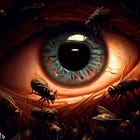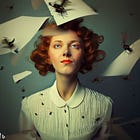A while ago when started his Substack I was surprised how much backlash he got in comments for using AI images. I figured that was just part of the trolling that celebrity attracts. However, I have seen many comments since that indicates that there is genuine animosity towards those of us who use of AI images. These threads seem to quickly attract the unhinged.
Yesterday, one individual said that he could not understand why creators would use it and then accused those who do of being plagiarists. It’s odd that someone who considers themselves a writer does not avail themselves of a dictionary. Such a precaution would have prevented him from wrongly accusing people of theft or outing himself as an imbecile.
I always give credit for every quotation, reference or image and I go to great lengths to make sure I get that right. At time of writing, I have 90 long-form published posts and and 213 in drafts and some have stock images, but not many. In every case I credit the creator.
Why I Use AI Images
The only image generator I have used so far is Bing Image Creator. I know Substack now has the facility but I have not tried it. I always credit the tool as Bing Image Creator Dall.E.2 or E.3 as the case might be and if I modify that is made clear too.
The images are created using my keywords, which I have to experiment with to get the results I want, so I am involved in the creative process. How is that worse than using a stock photograph taken by a real person who is anonymised by the image library?
For me, AI image creation has helped me to express abstract ideas, in a way that a stock photograph could never do. So let me give you just some examples of how I have used AI to express an idea in an image.
Imagery and Analogy
In the ongoing Series 11, I am talking about a particular incident of academic cancellation - it is an ongoing project. In the first episode I wanted to combine the idea of being at the centre of a media storm and the mindless nature of online mobs who are, for various reasons, insect-like in their behaviour. In the case of Hymenoptera in general, the ‘intelligence’ of the colony is an emergent property, and the actions of individuals are triggered by the environment that the colony provides.
Episode 2 was called ‘The Fly Papers’ because it referred to what I was characterising as insect-like behaviour in respect of the de-listing of authors on academic papers… which for anyone interested is a type of plagiarism.
For my 2024 New Year piece I generated and image that I called ‘Parade of Half-Eaten Memories’ and featured an apple with a bite taken out of it, to reveal the teeth underneath, with old photographic mementos scattered around. The piece was about nostalgia and the regret of ‘half-eaten’ opportunities and how many years later they have come back to eat away at me. I challenge anyone to find a stock photo that expresses that.
Another example is taken from my ongoing series on free-will. I wanted to talk about the ‘hungry judge’ study where is was apparently shown that decisions made in the morning tended to be harsher than those made after lunch. I was also discussing the neurology of decision making, so I wanted to combine the idea of hungry judges, and regions of the brain known as the hippocampi. The title came first, combining the themes of the judiciary, hunger and the hippocampus so ‘hungry hippos’ game came to mind. I set about generating an image that combined those themes and through considerable trial and error came up with this.
I have used photographs too and my favourite images were to me like finding treasure. I tracked one picture down to a couple who run a tourist guide site for Rome, Italy. I found them on Facebook and asked for their permission to use it which I got. When that is published I will link their travel site as they requested.
But what about public domain material? My most precious find stemmed from a line in the movie The Wizard of Oz which incidentally, was not in the original L. Frank Balm book, The Wonderful Wizard of Oz (1900).
“Pay no attention to the man behind the curtain!”
“The Wizard of Oz”, Noel Langley Screenplay, Movie released on August 25, 1939
The wizard tells the intrepid seekers to ‘pay no attention to the man behind the curtain’ and while I don’t want to give spoilers, it is a good analogy for the idea that there are things hidden that some people don’t want us to see.
The particular piece was on a special interest group who opposed the use of hydrogen and I was saying that they had a hidden agenda - it is one of many that I have written around that topic but this one had my favourite images. Other themes that were readily drawn upon were courage, the yellow brick road and strawmen. Here I am merely trying to show you what I was thinking of and why I felt so lucky to have found what I did.
I set out to find free images from the 1939 film but that was problematic and I felt it would be fraught with danger in terms of copyright. However, I came across some wonderful publicity photographs from the 1902/4 stage production which was the first time it was ever performed and the only one that the author Frank Baum worked on.
Look at these and tell me they are not wonderful.
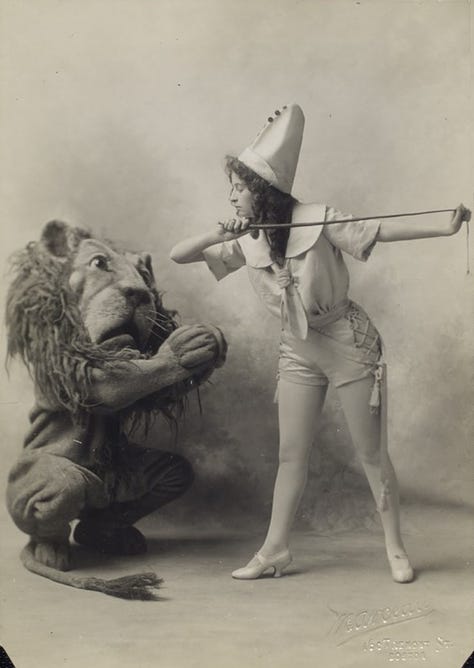
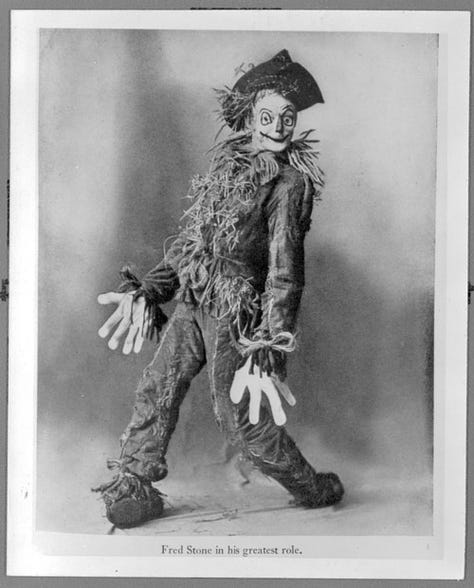
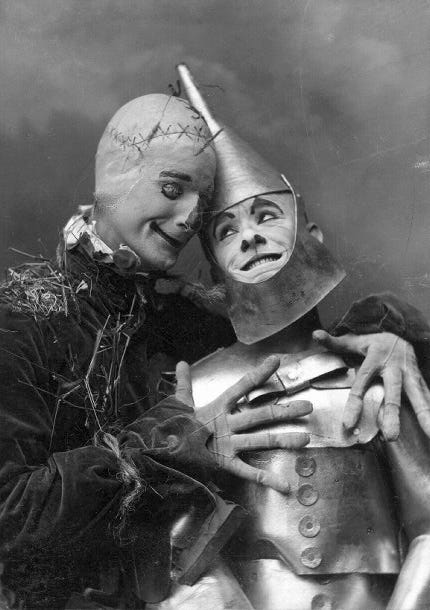
To find something that fits so perfect is rare. The reason I was able to find it at all was because I knew the themes so well and could align a number of them to what I wanted to say. Had I gone onto Wikimedia Commons (where I found these), or indeed any other stock photo library and searched in terms of abstract concepts, like ‘courage’ or ‘hidden agendas’ the chances are I would have come up empty. I happened to know I was looking for The Wizard of Oz.
Of course we can all find stock photographs of someone sat on the floor next to a wall, head in hands, looking depressed but is that good enough anymore? Maybe it is for you, but don’t use stock images and then accuse others of plagiarism or equally baffling, laziness. AI gives me the ability to generate original images out of abstract terms.
Use your stock photos, but have some self-awareness while you rummage for visual clichés, using your low Wattage power of borrowed thoughts. If you don’t like AI images then don’t project your prejudices onto others. Should you nevertheless be tempted to think they indicate poor quality content, just remember what is said about ‘books and their covers’, by people who are just as unoriginal as you.





